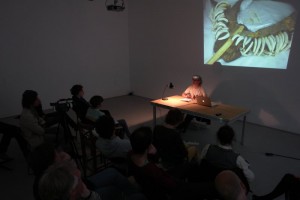RE/COLLECTING Was the title of the Outlet Inn on the 20th of June, shown within the yearlong project The Object Lag in Nieuwe Vide (Haarlem) curated by Emily Williams. The evening was organised by Eva Olthof and Charlotte Rooijackers.
Given the opportunity to work within Teylers Museum the title of the show refers to both to working with collective memory, remembering anew, as well to a personal navigation through the immense archive in which one uses the collection again, making a ‘new’ collection by selection.
Eva’s installation ‘Working on Volcanic Matter’ was on display and was the result of a research with as startingpoints the unknown fact that Holland has a volcano and a book on volcano’s from the Natural History Library in Teylers museum.
[See also other page 'Working on Volcanic Matter']
Martine Derks and Charlotte gave a per formative lecture about their navigation through Teylers Museum and its collection in the form a dialogue in which they were mimicking each other and describing a bodily relationship with the museum through a fictional narrative.
[See also other page 'Dear Museum, Dear Guests,]
Last but not least this evening anthropologist Mark Mulder gave a lecture on the immaterial aspects of anthropological objects, reflecting on his own research for the coming five years on Papua New Guinea and the role of the museum.
In preparation of Mark’s lecture:
(…)
As the title already makes clear the topic of my lecture will be the immaterial aspect of the object in (cultural) anthropology. Over the last twenty years or so material culture research has become one of the major undertakings of contemporary anthropology and after the invitation came to come and speak at the Re/Collecting event at Nieuwe Vide I thought this might be an interesting topic for the evening. In addition to giving a brief overview of the development and importance of material culture research, I thought I’d talk about my own project. My work at the Smithsonian and Tropenmuseum centered on an expedition that took place in 1926 following an American initiative with cooperation of the then Dutch-East-Indies Military and scientists. The stated goal of the expedition was to use modern technology (a hydroplane, wireless radio, film-cameras) find the ‘home-land’ of a supposed ‘pygmy’-population in the unknown interior highlands of what was then Dutch New Guinea (later Indonesian Irian Jaya, now officially known as the province ‘(West) Papua’). The expedition’s main results were substantial collections of ethnographic objects that were supposed to give a ‘complete overview of the native population’s material culture’. The expedition also resulted in a film – with only one surviving copy of any publicly shown cut in the Amsterdam Filmmuseum (the history of this copy is somewhat problematic) and some raw footage at the Human Studies Film Archives in DC. There are good photographic collections at the Royal Tropical Institute (KIT / Tropenmuseum) and the National Anthropological Archives in DC. Finally, there are two identical sets of unique audio-recordings of native songs – one in Berlin and one in Amsterdam. In Washington DC I have worked on the history of this expedition, but I always had the idea that it would be interesting to reconnect these objects, images and sounds with the people that originally produced them. This is a major aspect of my proposed PhD research during which I hope to return to the area originally visited by the expedition in 1926. (…)
Mark Mulder had studied at the following places: University College Utrecht (BA in Liberal Arts & Sciences, 2004), University College London / University of London (MSc in Social Anthropology, 2006) and Universiteit van Amsterdam (MA Cultural Heritage Studies, 2009). In August of this year he will start the PhD programme in Archaeology / Anthropology at Columbia University in NYC. He has been given a Fellowship at the Anthropology Department of Columbia University and a Fulbright Scholarship. Between 2007 and 2009 he has spent three periods (totaling 18 months) as a visiting scholar in the Ethnology Department at the Smithsonian Institution’s National Museum of Natural History in Washington, DC. Mulders MA-thesis for the University of Amsterdam was based on research done at the Smithsonian Institution and the Tropenmuseum in Amsterdam.
